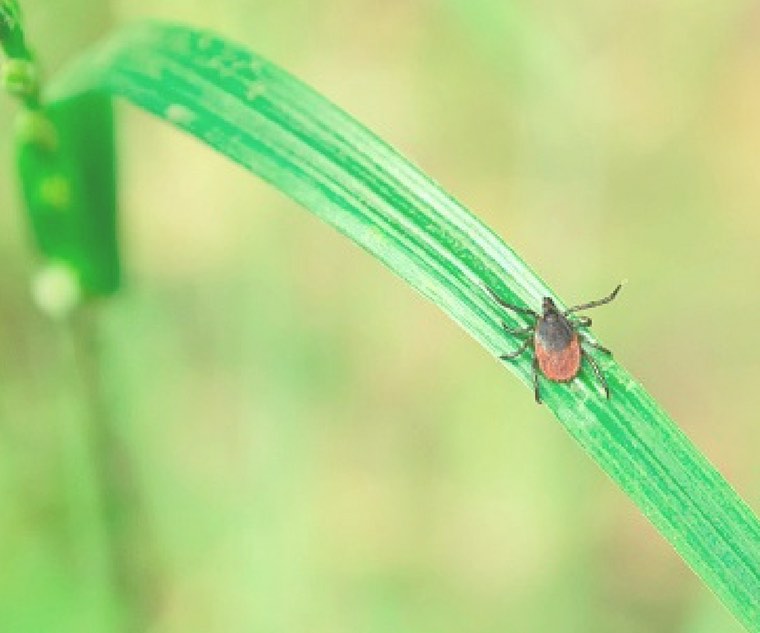
Merrill Lynch’s Charles Balducci almost died from Lyme disease. Here’s what he learned and how he’s working with the nonprofit Global Lyme Alliance to fight the spread of this dangerous illness.
Lyme disease, the illness that’s spread via deer ticks, is a growing and dangerous phenomenon. Few people know this better than Charles Balducci, a managing director and wealth advisor at Merrill Lynch, who battled the disease more than a decade ago. Worth spoke with Balducci about his experience and his subsequent work with the nonprofit Global Lyme Alliance. HOW DID YOU GET LYME DISEASE? In July 2004, I was playing golf in Montauk, Long Island, where I have a home. Halfway through the round, I felt something funny, and I had a tick that was sitting on my hip. Actually, in my hip. I kind of threw it off and didn’t think much of it—I just thought, I want this little bugger off me. About a month later, I got a 105-degree fever—105 is really high. I was concerned. I had a really stiff neck; I thought I had meningitis. I went to a doctor in Brooklyn who tested me, and he said he didn’t think I had meningitis, he’d give me antibiotics and I should be okay. I got them and pretty quickly felt better. BUT YOU WEREN’T BETTER? A month later, in August, I got married and went on my honeymoon in Kenya and the Seychelles—storybook wedding, beautiful honeymoon. But towards the last week, I was just feeling awful. I had no energy, couldn’t keep up with my wife on a bike or hiking. And then I got a low-grade fever. I thought I must have gotten malaria when I was in Kenya. SOUNDS LOGICAL. DID YOU GO TO A DOCTOR? We flew back to New York, but coming through the airport I was so ill that I had to use a luggage mover as a walker. I couldn’t stand up. I got to the emergency room at Weill Cornell [Hospital in New York], and they tested my vitals. The machine for blood pressure didn’t work. They got another one, and that didn’t work. There were no numbers showing up. So the nurse tested me manually; the machines weren’t broken—they just weren’t registering. She told me, “Your heartbeat is 26 beats a minute. You should be unconscious by now.” I DIDN’T KNOW YOU COULD LIVE WITH A HEARTBEAT THAT SLOW. A professional bike rider or soccer player probably has a resting heart rate in the high 40s. For me to be in the 20s meant that I was probably a day or so from dying. WHAT HAPPENED NEXT? They rush me into surgery and put a temporary transvenous pacemaker in me. The disease specialist said, “This is very rare, but I think you have Lyme disease, and the bacteria is surrounding your heart and blocking the electro-physiology of the heart.” So they put the pacemaker in me, then an IV tube called a PICC line that went up into my heart for 11 days, pumping me with antibiotics twice a day. My tests came back positive—I had Lyme disease. And, slowly but surely, I got better. Within a month, I had made a complete recovery, and I’ve never had another symptom. SO THAT EXPERIENCE MOTIVATED YOU TO PROMOTE AWARENESS ABOUT THE DISEASE? Once I got better, I aligned myself with a small Lyme disease charity called the Turn the Corner Foundation. We merged with another Lyme disease group and rebranded ourselves as the Tick-Borne Disease Alliance, and then a couple years later we merged with Greenwich, Connecticut’s largest Lyme disease charity, the Lyme Research Alliance. We’re now known as the Global Lyme Alliance with a 35-member board, a CEO and staff of 10—wonderful, wonderful people. We went from raising, when I first started, a couple hundred thousand dollars a year to about $4 million a year. About 65 percent of our money, maybe 70, goes to research, and the balance goes to education and awareness. SPEAKING OF EDUCATION… I WAS UNDER THE IMPRESSION THAT ONCE YOU HAD LYME DISEASE, IT REALLY COULDN’T BE CURED AND THAT SYMPTOMS WOULD PERIODICALLY RECUR THROUGH THE REST OF YOUR LIFE. SO THAT’S INCORRECT? Being symptom-free is not unusual. There are acute Lyme cases—I had one—that are very curable. If treated early and aggressively, often you do get better. OFTEN BUT NOT ALWAYS? If you’re not treated properly or if you’re misdiagnosed or not diagnosed, period— because the diagnostic tools now in existence are awful, maybe 50 to 60 percent accurate. So if the Lyme exists in your body for any lengthy period of time, it is really hard to get rid of and really hard to treat. You can do it, but it’s very, very challenging. And you’ll have folks who have been treated and get better and get post-treatment Lyme disorder, in which they have symptoms that can come back after treatment. HOW MANY CASES OF LYME DISEASE ARE THERE IN THE UNITED STATES EVERY YEAR? The CDC would suggest there are confirmed about 30,000 cases a year. We believe the numbers are much, much higher. Research has shown there are about 300,000 cases a year. Many go undiagnosed or misdiagnosed. AND ARE THERE GEOGRAPHIC PATTERNS TO ITS PREVALENCE? Lyme exists all over the U.S., in all 50 states. It has been shown to be more prevalent in the Northeast. If you ever look at a Lyme map, there are massive concentrations in Texas, the Great Lakes, Michigan, Wisconsin, California. And so there are Lyme organizations all over the country. There has not been one definitive organization. We want to be that one organization that can coalesce all these people who are trying to do some good in the world. WHY THE PREVALENCE IN THE NORTHEAST? Lyme was first discovered in Lyme, Connecticut—hence the name. We believe that the ecology of the Northeast is perfect for ticks and the animals that harbor them—white-tailed deer and squirrels and mice and rabbits. I’VE BEEN READING THAT THE TICK PROBLEM IS PARTICULARLY SEVERE THIS SUMMER, AND ANECDOTALLY I FEEL LIKE I’VE BEEN HEARING ABOUT MORE CASES OF LYME AMONG PEOPLE I KNOW. WHAT’S UNUSUAL ABOUT THIS SUMMER? The problem is that we had a mild winter, so there was a massive acorn drop. Acorns are a primary food supply for mice and squirrels, so their populations have simply exploded, and they are one of the primary carriers of deer ticks. We believe the population of ticks has risen along with them, and there can be as high as a one-in-three chance of a tick carrying Lyme or another tick-borne illness, of which there are around 30. WHAT ARE THE SYMPTOMS THAT PEOPLE SHOULD LOOK OUT FOR? YOU HEAR A LOT ABOUT THE BULLSEYE RASH. The bullseye is a direct indicator that you have Lyme disease, but it only shows up maybe half the time. Or you could be bitten in your scalp where you’d never see it. Or, if you have a darker skin tone, it just may not be as pronounced as someone with a lighter skin tone. So then what you need to look for are odd situations and trusting your body. If you have flu-like symptoms in the middle of the summer, a very high fever, major fatigue or joint pain that comes out of nowhere, or headaches or sensitivity to light and noise, you might have Lyme disease. THAT’S QUITE AN ARRAY OF SYMPTOMS, AND A LOT OF THEM SOUND LIKE THEY COULD BE THE RESULT OF ANY NUMBER OF THINGS. Lyme is the great imitator. Its symptoms resemble many different illnesses—ALS, fibromyalgia, multiple sclerosis, arthritis. The challenge is there’s a lot of misinformation out there. Our website is very fact-based, but a lot of what you read on the CDC website and other places is not, in our judgment, entirely accurate. There’s a lot of fringe out there, and we want to be the adult in the room. WHAT CAN PEOPLE DO TO PREVENT GETTING LYME IN THE FIRST PLACE? I LIVE IN A SUBURBAN AREA, AND I’M CONSTANTLY GETTING FLIERS FROM LAWN CARE COMPANIES THAT SAY THEY’LL SPRAY MY LAWN AGAINST TICKS. DOES THAT WORK? It definitely works. You should have your lawn sprayed. There are a variety of different chemical and organic-based treatments that can be effective. If you want to take it to the next level, you can have critter boxes put on your property that treat mice or squirrels with permethrin. It doesn’t harm the animal but will kill the ticks that those hosts would carry. WHAT ELSE DO YOU RECOMMEND? If you have small children and they’re going outside, they should be wearing light-colored clothing. Parents should have tick checks every time the kids come in from playing and also at bath or shower time. And if you have an animal in the house, the prevalence of Lyme disease more than doubles. DO HOUSE PETS GET LYME, OR ARE THEY JUST HOSTS FOR THE TICKS? Dogs can get very sick from Lyme disease, and we’ve funded some research into that. ANOTHER TICK-BORNE DISEASE, CALLED POWASSAN, HAS BEEN GETTING A LOT OF ATTENTION RECENTLY BECAUSE SEVERAL PEOPLE HAVE DIED FROM IT. WHAT DO YOU KNOW ABOUT IT? Powassan is of particular concern because it’s so deadly. Within 24 hours [of being infected] you can start showing meningitis-like symptoms and be very ill. It’s actually been around since the 1950s, but there aren’t that many confirmed cases—maybe 75 to 100. But in 50 percent of them people pass away, and in the other 50 percent people have permanent damage. YOU MENTIONED THAT THERE ARE SOME 30 TICK-BORNE DISEASES. A tick can carry multiple viruses, and you can carry multiple viruses at the same time. So if you’re not going to see a Lyme–literate doctor, they might treat you for one disease and overlook another. DOES THE GLOBAL LYME ALLIANCE WORK WITH DOCTORS? We spend a fair amount of money educating doctors and putting together curricula through some major educational institutions to train doctors and teach them what to look for and how to treat. We have compiled a list of Lyme-literate doctors on the GLA website. If people email us, we will email them right back with a list. Read the entire article on Worth.com Charles Balducci serves as a Vice Chair on GLA's
Board of Directors.
Charles Balducci serves as a Vice Chair on GLA's
Board of Directors.






-2.jpg)
